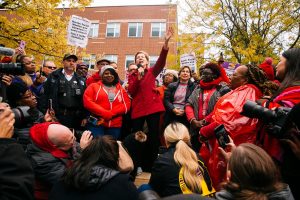
CTU organized an 11-day strike in late 2019 where the union demanded, along with salary raises and improved benefits, “greater investment in and protections for students and staff, at school and in the community” (Goldstein 2019). These included sanctuary for undocumented students and staff, decreased funding for SROs, increased mental health staff, nurses, counselors, librarians, reduced class sizes, and even affordable housing (Gullapalli 2019). This strike gathered the attention of several Democrats campaigning for the presidency, utilizing the strike to show their commitment to America’s unions. Senator Elizabeth Warren stopped in Chicago to express her support for the strike. The Senator joined those striking to shake hands and offer her support. She stated, “The unions are how we have a voice. The unions are how we have power. The unions are how we make sure that the needs of every one of our children are heard loud and clear” (Smith 2019). These candidate visits, while beneficial for campaign optics, helped the strike gain national attention, placing the issues of Chicago’s students as the issues of students around the country, and bringing focus to the progressive issues Chicago educators were advocating for.
Several of CTU’s demands were met following the 2019 strike, but not all. In the end, the city agreed to spend millions of dollars on reducing class sizes, promised to pay for hundreds more social workers, nurses, and librarians, and approved a 16 percent salary increase over the coming five years (Smith 2019). Not all union members were satisfied with this deal. Following this strike, a vote to approve a tentative agreement was noticeably split. Some teachers wanted to press on to seek steeper reductions in class sizes, more teacher preparation time, and special education aid (Smith 2019). Additionally, no contractual changes were made regarding SROs in Chicago Public Schools. Despite these strike’s shortcomings, the successful demands prove that social justice unionism is a powerful and effective strategy, and that teachers unions do have strength to advocate for concerns beyond wages and benefits. Chicago’s strike proves to educators across the country that union power can be utilized to advocate for the common good of students and their communities.
In June of 2020, following a wave of protests against the murder of George Floyd, there was a national movement against police presence in schools. The Chicago Teachers Union, along with several other community groups, organized a march in response. They demanded that Chicago Public Schools terminate their $33 million contract with the Chicago Police Department. Instead, they argued, the money should be spent on additional school counselors, psychologists, nurses, and social workers. In a statement regarding the march, CTU stated, “Those funds could instead have funded more than 65 additional sustainable community schools that provide desperately needed student services” (Parella-Aureli 2020). At the march, Jitu Brown, national director of the Journey For Justice, read aloud the group’s demands for Mayor Lori Lightfoot and Chicago Public Schools. He stated, “We are demanding all police out of Chicago Public Schools,” he said. “We are demanding PPE for all. We are demanding that every school with over 70% free and reduced lunch becomes a sustainable community school. We are demanding that we want a teacher to student ratio of one to 15. … We are demanding a nurse in every school” (Devereaux 2020). This march received extensive media attention and showed a united educator community around racial and social justice issues.
Organizers continue to face challenges from Chicago’s major Lori Lightfoot on this issue. In June, Mayor Lightfoot announced that the city has no plans to end the school’s contract with the police (Schulte 2020). When asked if she would consider canceling Chicago Public School’s contract with the Chicago Police Department, Lightfoot stated, “Yeah, we’re not gonna do that…Unfortunately, we need security in our schools” (Masterson 2020). Despite Lightfoot’s rigidity on the issue, there has been a positive change since June’s protest. In August, CPS announced that 17 of the city’s public high schools would no longer have Chicago police officers in their buildings (Pathieu 2020). Additionally, CPS is changing its current partnership with the Chicago Police Department. CPS announced that they are strengthening eligibility requirements for resource officers. Officers are no longer allowed to enter student names into the police department’s gang database or cooperate with immigration officers (Masterson 2020). These changes do not absolve the core concerns of police presence in schools, but do show the start of an evolved relationship between CPS and CPD. Similar to the 2019 strike, this march shows the potential impact of this type of progressive educator organizing, although further organizing is needed on the issue.
Image: Smith, M. (2019, October 22). National Democrats Signal Support as Chicago Teachers’ Strike Stretches On. Retrieved December 13, 2020, from https://www.nytimes.com/2019/10/22/us/elizabeth-warren-chicago-teachers-strike.html